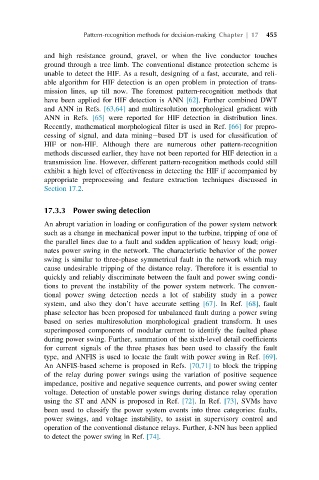Page 495 - Decision Making Applications in Modern Power Systems
P. 495
Pattern-recognition methods for decision-making Chapter | 17 455
and high resistance ground, gravel, or when the live conductor touches
ground through a tree limb. The conventional distance protection scheme is
unable to detect the HIF. As a result, designing of a fast, accurate, and reli-
able algorithm for HIF detection is an open problem in protection of trans-
mission lines, up till now. The foremost pattern-recognition methods that
have been applied for HIF detection is ANN [62]. Further combined DWT
and ANN in Refs. [63,64] and multiresolution morphological gradient with
ANN in Refs. [65] were reported for HIF detection in distribution lines.
Recently, mathematical morphological filter is used in Ref. [66] for prepro-
cessing of signal, and data mining based DT is used for classification of
HIF or non-HIF. Although there are numerous other pattern-recognition
methods discussed earlier, they have not been reported for HIF detection in a
transmission line. However, different pattern-recognition methods could still
exhibit a high level of effectiveness in detecting the HIF if accompanied by
appropriate preprocessing and feature extraction techniques discussed in
Section 17.2.
17.3.3 Power swing detection
An abrupt variation in loading or configuration of the power system network
such as a change in mechanical power input to the turbine, tripping of one of
the parallel lines due to a fault and sudden application of heavy load; origi-
nates power swing in the network. The characteristic behavior of the power
swing is similar to three-phase symmetrical fault in the network which may
cause undesirable tripping of the distance relay. Therefore it is essential to
quickly and reliably discriminate between the fault and power swing condi-
tions to prevent the instability of the power system network. The conven-
tional power swing detection needs a lot of stability study in a power
system, and also they don’t have accurate setting [67]. In Ref. [68], fault
phase selector has been proposed for unbalanced fault during a power swing
based on series multiresolution morphological gradient transform. It uses
superimposed components of modular current to identify the faulted phase
during power swing. Further, summation of the sixth-level detail coefficients
for current signals of the three phases has been used to classify the fault
type, and ANFIS is used to locate the fault with power swing in Ref. [69].
An ANFIS-based scheme is proposed in Refs. [70,71] to block the tripping
of the relay during power swings using the variation of positive sequence
impedance, positive and negative sequence currents, and power swing center
voltage. Detection of unstable power swings during distance relay operation
using the ST and ANN is proposed in Ref. [72].InRef. [73], SVMs have
been used to classify the power system events into three categories: faults,
power swings, and voltage instability, to assist in supervisory control and
operation of the conventional distance relays. Further, k-NN has been applied
to detect the power swing in Ref. [74].

